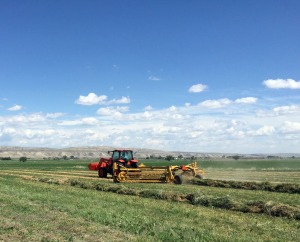.
I have trouble keeping my houseplants alive.
I gotta’ hand it to those girls (and guys) that know the difference between orchardgrass and brome grass and alfalfa – much less how to mix up the seeds and grow an effective hay harvest.
.
For soil health, it’s a good idea to mix grasses (example, brome grass) and legumes (example, alfalfa)… but if a farmer isn’t careful, the legume will take over after a few years and there won’t be any grass left.
.
Did you know that feeding the correct hay is more than just throwing around dried grass?
It’s all about the nutrient content (like the food pyramid for animals), moisture content (how much water is in the vegetation), crude protein amounts (think about your breakfast shake)… and more!
Some hay is better for cows than for horses. And different hay is more beneficial for certain animals depending on their stage of development.
Is this stuff that typical “city folk” know?
.
P.S.
The photo is a tractor with a rake. The driver is scooping all of the cut hay into big windrows so that it’s ready for the bailer – yep. you guessed it – to bail the hay into big round bales.
.
Did you already know that too?
.
.

Good, interesting information. Thanks. I do wonder what keeps these rolls of hay that sit in the rain from molding?
LikeLike
Actually, me too! I’ll see what I can do to find out.
I did watch a video the other day about storing round bales – they suggested keeping them as dry as possible and also storing them end to end (so the flat sides are pressed up against each other to make one continuous tube of hay). I am thinking that the hay is pressed together so tightly that water is somewhat repelled away from the surface instead of sinking in??
I’m really just a town-kid myself.
Stay tuned! I’ll ask around!
LikeLiked by 1 person
Looking forward to your info!
LikeLike
Okie dokie!
This is the answer I got from the University of Wyoming’s Northwest Area Extension Educator specializing in Agriculture and Horticulture –
“What keeps the rolls of hay that sit in the rain from molding? I am interpreting the rolls of hay to mean round bales, so if I misunderstand please correct me. The short answer is yes hay is packed tight enough to keep water out to a degree.
So here is the long answer. One of the most critical times for hay to mold is from the time it is cut to the time it is baled, once baled the hay has more protection from molding. There are also two ways hay bales mold, from the inside and from the outside. If a bale is baled too wet, then it will mold from the inside out and has the potential of igniting on fire from the heat generated by the microbial activity. If hay is baled correctly meaning packed tightly and at the proper moisture, then this hay can be stored for later use. Here in the west we typically do not cover our hay because our climate is so dry that even if the bales get rained on the bales dry out rather quickly, as compared to the east such as Missouri, Iowa, etc., their climate is so humid that you cannot store hay without protection. For round bales the round structure of the bale encourages water to roll off the bale and some producers use a net wrap which can also protect the hay. Hay bales do absorb water from rain, snow, etc., depending on how hard and much the moisture can the deeper the moisture could potentially penetrate the bale.”
LikeLiked by 1 person
Thanks! I appreciate your answer. Now I know too!
LikeLike